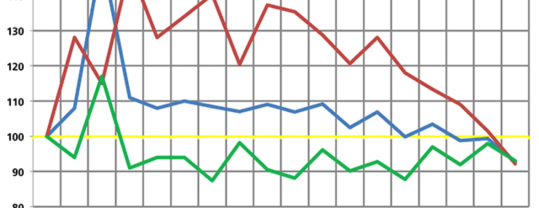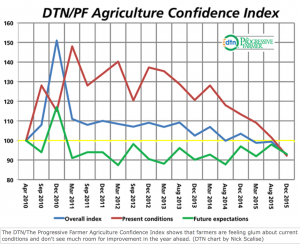OMAHA (DTN) — Farmers’ discontent with crop input prices and farm incomes has continued to grow while hope of an economic turnaround has faded, according to the latest results of the DTN/The Progressive Farmer Agriculture Confidence Index.
The latest reading of the index came in at 92.7, compared to 99.4 in August and 103.4 in December 2014. An index value of 100 is considered neutral, while higher values indicate optimism and lower values reflect pessimism.
The index is an average of farmers’ and ranchers’ assessments of their present situation and their expectations of conditions 12 months from now, and low hopes of improvements in the ag economy have led to the lowest confidence index since DTN began surveying farmers in April 2010.
“Farmers have never felt worse about their current financial situation in the history of the DTN Ag Confidence Index,” said index creator and agriculture economist Robert Hill. “It’s declined precipitously from where it was at this time last year, and it was at a low point then, too. Not only have crop producers reached these new lows this year, but now the livestock producers have joined them. It’s ugly all around and not expected to turn around within the next 12 months.”
DTN surveyed 500 agricultural producers from Nov. 2 to 25. DTN conducts the survey before planting, before harvest and after harvest each year to gauge farmers’ attitudes at key times of the crop cycle.
Disappointment with the ag economy has been factored into the index for more than a year. However, 2015’s post-harvest survey included a few points that emphasize farmers are settling in for a prolonged down cycle.
For the first time, a majority (53%) of survey respondents classified current input prices as bad, although that number has been on the rise since March 2014.
Also for the first time, more farmers consider their current incomes as bad (44%) than normal (42%).
More than 50% of respondents said they think inputs and incomes will be the same one year from now.
“Farmers are facing some hard economic realities,” Hill said.
AGRIBUSINESS BOUNCES BACK FROM AUGUST LOWS
DTN also surveyed 100 local agribusinesses from Nov. 12 to 19 about their feeling toward the current business environment.
The DTN/The Progressive Farmer Agribusiness Confidence Index rebounded to 98.3 from its all-time low of 92.7 last August. Last year, the post-harvest reading was 105.5.
“For the businesses serving the famers, the index scores are also quite low, but not historically low like it is with the farmers,” Hill said. “It is difficult to see light at the end of the tunnel for the nation’s farm supply industry. Manufacturers are trimming expenses and cutting into overhead in reaction to the current farm economic environment.”
Mike Cline works on his Indiana family farm and helps run their elevator business, Cline Grain. While it’s been a tough season — their bins aren’t full despite offering a positive corn basis — he said they’re feeling more positive than before harvest.
“I don’t think we saw lows like we thought we would,” he told DTN. “We’re looking for corn in my area. We pre-contracted some with early bids in September and got a good cash price. We’re feeling fairly good about it right now where we sit.”
Cline thinks the blow of low prices is softer on agribusinesses than it is for farmers. Business drops off slowly instead of steeply, like farm incomes tend to do. USDA forecasts that 2015 net farm income at $93 billion, a decline of 28% from 2014 and 55% from 2013.
“I think a lot of the farmer pullback has already happened,” he said. “I don’t think they will pull back much more unless it drops back to $2 corn range, and then our sentiment would really change.”
The Agriculture Confidence Index also breaks responses down by crop and livestock operations. The crop producer index has been reflecting tight economic conditions since March 2014.
The livestock index hasn’t always been rosy, but in the past, it was expectations of worsening conditions in the future that caused negative readings.
This survey, however, was different. While the overall index sits at a pessimistic 96.4, the index for present conditions, at 105.2, is the lowest it’s been since DTN began surveying five year ago. That’s sharply lower than the mid- to late-August rating of 122 and likely reflects volatility in the cattle futures market throughout the autumn months, said DTN Livestock Analyst John Harrington.
“This market has just collapsed since the last third quarter. Losses are, like, $500 per head,” Harrington said. “It was going to be a tough year anyway, and then the wheels came off beef demand.”
With high U.S. retail prices and the strong dollar, exports also dried up. “It just rubbed salt in the wound, and that’s why we’re limping badly into the new year. The equity situation has just been crippling. As for the pessimistic view — I’m not surprised,” Harrington said.
INPUT AGONY
Discontent with input prices is at an all-time high, according to DTN survey data.
“From land rentals to seed and fertilizers, all input costs are being more closely scrutinized. Equipment investment has dried up,” Hill said. “Evidence of growers falling into a bunker mentality is coming out of the seed corn industry where growers are delaying order placements, which is putting a lot of pressure on seed suppliers.”
Cory Ritter, who farmers near Blue Mound, Illinois, said he has started to carefully consider his input purchases, especially seeds. Some farmers in his area switched to conventional varieties last year and had success. He thinks more will make the switch this year.
“I haven’t made those decisions yet. I’ve got to run the numbers on everything,” he told DTN. “I also have a good window here before I have to put the actual corn in the ground. So, maybe something breaks or gives. It leaves some options open.”
While Ritter thinks current input prices are too high — fuel is the exception — he thinks prices probably were too low at some points when crop prices were high.
He wishes he knew where input prices would be 12 months from now. “My gut reaction tells me it has to go lower, but the market never has to do anything. The prices don’t have to do anything.”
Ritter said they did a lot of soil testing this year and knows where they can cut back on inputs and where they can’t. “You don’t want to cut back too much because you need the bushels to sell. You have to walk that fine line of getting top yield on a budget.”
NO RAINBOWS AND UNICORNS (OR MANAGING THE DOWN CYCLE)
USDA is forecasting 2015 farm incomes will be the lowest since 2002. The outlook for corn prices isn’t much different.
USDA’s baseline forecast calls for farm gate prices to average between $3.60 and $3.70 for the next five years. The baseline forecast assumes there are no major changes in macroeconomics or supply and demand shocks in the marketplace.
Cline said on the farming side of the family operation, the outlook for next year isn’t terrible.
“It will be tight, and we’re looking at places to cut,” he said. “But at no point do I think we’re going to fail miserably. Interest rates aren’t like we were in the ’80s, and I think we’re in a way better position than ’80s.”
Ritter said there’s plenty of nervousness about income right now. It’s essential to know your break-evens and take advantage of the market when it gives you an opportunity.
“We knew that $7 to $8 corn wasn’t going to last, and most likely $3 corn isn’t going to last. There’s probably a happy medium, and it’s the job of the marketplace to find that,” he said.
While the DTN index for farmers’ expectations for a year from now is still negative at 93.1, Cline and Ritter think they’ll find a way to make to make it work.
“I guess I’m cautiously optimistic, because as a farmer we have to be. We put a lot of faith in putting seed in ground and hoping it’s going to grow,” Ritter said.
“You know it’s not always going to be rainbows and unicorns. There are tough times, but you prepare for the tough times. It moves in cycles. We’re in a down cycle. At some point, it’s going to go back up. Is it next year? I don’t know. Is it five years from now? I don’t know. But everything moves in cycles.”
For more information about the index, please visit http://about.dtnpf.com/…
Katie Micik can be reached at Katie.micik@dtn.com
Follow her on Twitter @KatieMDTN


